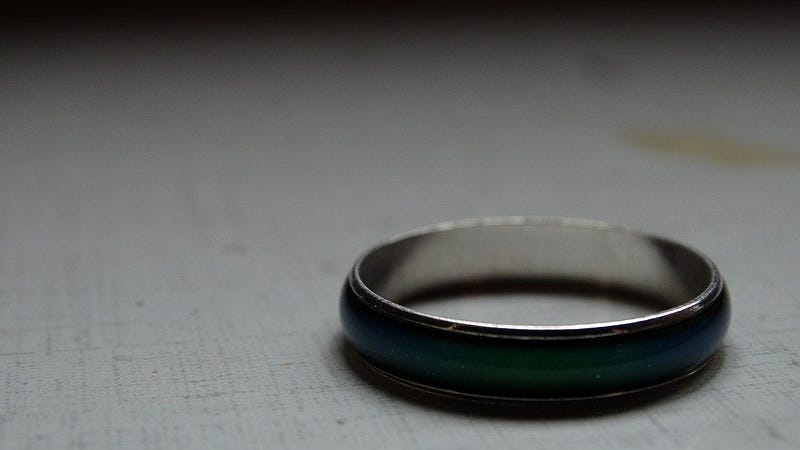How Do Mood Rings Really Work?
By Catrin Zharyy, Behavioral Neuroscience, 2023

The smallest piece of magic you can hold in your hand, a mood ring and its power to channel one’s innermost emotions into trippy blends of color has charmed children and adults alike for close to 50 years. Since reaching peak popularity in the 1970s, the mood ring’s selling point has always been that it mystically changes color depending on the temperament of the wearer. It might be easy to pass off the mood rings and necklaces that crowd out gift shops as just another kiddish gimmick; but, in fact, they are rooted in more science than crookery.
At the heart of mood ring “technology” is the unique chemistry and physics of liquid crystals. These naturally exist in a molecular state neither completely solid nor liquid. The components of liquid crystals tend to maintain their order similarly to the atoms of a solid, but can shift their orientation with a fluidity more like a liquid.
Materials which exist flexibly between normal states of matter are called mesogens. For each liquid crystal mesogen — the major types are thermotropics, polymerics, and lyotropics (used in soaps) — the particular chemical compounds that make up its molecules dictate the mesogen’s physical, electronic, and optical properties. Furthermore, liquid crystal mesogens can exist in different molecular organizations called mesophases: the most common liquid crystal mesophases are nematic, cholesteric, and smectic. The “stone” in a mood ring is actually a hollow piece of glass or quartz filled with cholesteric thermotropic liquid crystals.
At the heart of mood ring “technology” is the unique chemistry and physics of liquid crystals. These naturally exist in a molecular state neither completely solid nor liquid.
Nematic and cholesteric liquid crystals have similar formations; their molecules, characterized as “rigid rods,” are randomly positioned but all point in the same direction. In a nematic crystal, the molecules in each layer point in the same direction as those in the adjacent layer. But as one moves through a cholesteric crystal, the direction of the molecules changes slightly — when all the layers are seen together, the molecules appear to organize in a helical manner.
The unique organization of a cholesteric crystal enables the circular polarization of light, giving mood rings their color. Light polarization occurs when a beam of light that contains lightwaves lying in different planes interacts with a medium which leaves it yielding lightwaves lying in only one plane. As light enters a cholesteric thermotropic liquid crystal, it is sequentially refracted through differently oriented layers of molecules, causing it to exit the crystal at different angles (this is the circular part of circular polarization). The varied direction of lightwaves minimizes wave interference and enables reflection and absorption of a diversity of light wavelengths, AKA colors.
So how can all this be manipulated to reflect something as abstract as a human emotion? Changes in emotion manifest themselves in changes in one’s external body temperature. The base of the ring conducts heat to the cholesteric thermotropic liquid crystals, whose molecular helical organization twists in response. The resulting elongation or compression of the crystal “spring” structure enables the absorption of varying wavelengths of light.
In a neutral emotional state, the crystals hardly twist and naturally reflect blue/green light. In a more passionate state, the body directs more blood to the surface of the skin, heating up the crystals and compressing the molecular helix, which in turn reflects shorter wavelengths of light like indigo and violet.
Effectively, the mood ring-wearer is changing the color of liquid crystals with her brain.
In more alert states, ranging from excitement to anxiety, the body’s physiological response is to direct blood away from the skin and toward the internal organs. The skin becomes colder, the “spring” in the crystals elongates, and the mood ring reflects longer wavelengths of light like yellow, red, and brown. Effectively, the mood ring-wearer is changing the color of liquid crystals with her brain (more specifically, the brain’s awesome body-regulating abilities).
Of course, sometimes the body’s temperature can change as a result of factors unrelated to emotion (simply being in a cold environment or releasing heat during exercise can tip off the crystals). But the mood ring’s marketing is not so deceptive — to some extent, there is a real connection between one’s mood and the colors that appear.
A child will explore and test out a mood ring to no end; it’s only as age creeps in that a person abandons more and more of his curiosity for cynicism and exhaustion. Fortunately, it only takes some research and experimenting to come closer to the truth: that magic exists. Maybe not in a mood ring itself, but in the laws that dictate the natural world. And that thing a kid would call a magic trick is really what we call science.
Liquid Crystals (2007). DOI:10.1002/0470084030
Molecular Crystals (1969). DOI: 10.1080/15421406908084865
Optical Materials (2015). DOI: 10.1016/j.optmat.2015.07.010